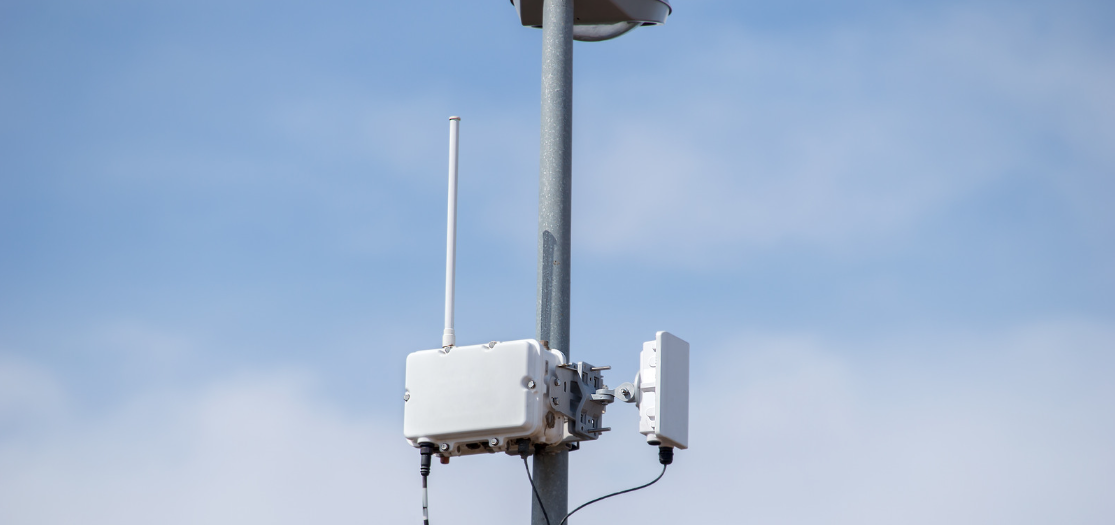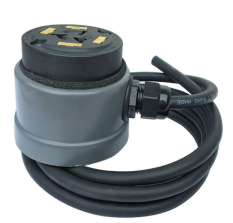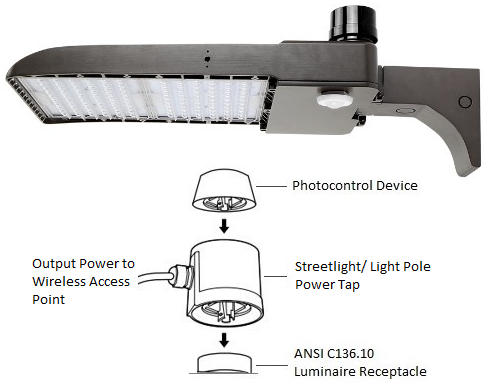Powering Wi-Fi Hotspots using Streetlights (Telecom Infrastructure Project)
 Streetlight Power for Access Points
Streetlight Power for Access PointsBuy Streetlight/ Light Pole Power Taps:
The Telecom Infra Project (TIP) has been involved in various initiatives to advance telecom network technologies, including the deployment of public wireless access solutions using portions of the unlicensed spectrum. One of the key focus areas for TIP has been developing solutions for high-performance and cost-efficient access networks aided by innovative algorithms.
 Wireless Access Point on a Light Pole
Wireless Access Point on a Light PoleThis initiative, led by the Millimeter Wave Networks Project Group within TIP, aims to deliver gigabit data rates to residential and consumer customers, support mobile backhauls, and enhance connectivity for smart cities. They propose leveraging the 60-gigahertz frequency band (spanning 57 to 73 GHz), typically unlicensed, to place access points on light poles. The 60-GHz Wi-Fi, adhering to the IEEE 802.11ay standard released in 2021, offers up to 8.64 GHz of bandwidth.
For powering the installations, the easiest approach is integrating them with existing infrastructure, like streetlights.
 7 Pin Streetlight Power Tap (Wire Termination)
7 Pin Streetlight Power Tap (Wire Termination)This method is practical for the following reasons:
- Ready Power Supply: Streetlights have an existing power supply, which can be tapped into for the access points. This eliminates the need for a separate power infrastructure, reducing installation complexity and costs. (Read more about Streetlight Power Taps)
- Pre-existing Infrastructure: Streetlights are already widely distributed throughout urban areas. This pre-existing infrastructure reduces the need for constructing new towers or poles, thus minimizing environmental and visual impact.
- Elevated Positioning: The height of streetlights is beneficial for signal propagation, as it helps in overcoming obstacles that could block or degrade the wireless signals.
- Maintenance and Accessibility: Streetlights are already maintained by municipal services, allowing for easier access and maintenance of the installed equipment.
 Connecting your Streetlight Power Tap
Connecting your Streetlight Power Tap
Using 60-GHz frequencies for wireless communication faces the challenge of oxygen absorption, which leads to signal attenuation and reduced range. These frequencies are best suited for short-range links, typically less than 100 meters, which can be effective in densely populated urban areas.
However, optimal strategies for utilizing these transmissions in city environments, including the ideal placement height of access points to circumvent signal scattering by obstacles, are still areas requiring further exploration and understanding.
Contact a Power Solutions Specialist for help with any questions on your streetlight/ light pole power taps.
Related Articles
RV Park Wi-Fi Solution: Powering Ruckus Wireless Access Points using POE Power from Streetlights
Buy Streetlight/ Light Pole Power Tap Adapters: Recreational Vehicle (RV) parks in the United States are increasingly seeking new solutions to improve efficiency and sustainability, while offering users a more modern, safe and connected experience. ...Powering Aruba 580 Series Outdoor Access Points using AEL 247L LED Streetlight Luminaire - American Revolution
With its exceptional Wi-Fi 6 performance, the Aruba 580 Series Outdoor Access Points are a great choice for harsh outdoor settings. These access points include 5 Gbps Ethernet connectivity in addition to high-power Bluetooth and Zigbee radios. Aruba ...Powering the TP-Link EAP225 Access Point with the FP288A-120-BBN-A Streetlight Power Tap
The TP-Link EAP225-Outdoor is a high-performance AC1200 Wireless MU-MIMO Gigabit Access Point crafted to deliver dependable dual-band Wi-Fi for indoor and outdoor applications. With maximum speeds of 300 Mbps on the 2.4GHz frequency and 867 Mbps on ...Powering the Pelco Spectra Enhanced IR Look Up 7 Series - 2 MP 30x Surveillance Camera using 240VAC Streetlight Power
Integrating advanced surveillance systems into urban environments demands both exceptional technology and reliable power sources. The Pelco Spectra Enhanced 7 Series cameras offer state-of-the-art surveillance capabilities, providing high-quality ...Powering The Sentry 6000 Series Pole-Mounted Standalone Security Camera System with FP285A Streetlight Power Tap
The Sentry 6000 is a rugged portable or permanent Surveillance solution that can be used in extreme outdoor conditions. It is well-designed with flexible mounting options and configurations, making it one of the best customizable security solutions ...